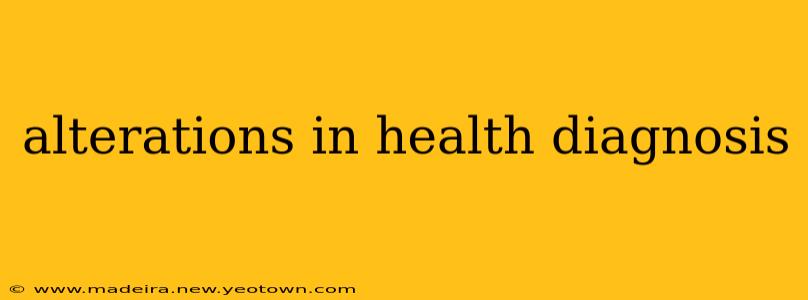The world of health diagnosis is in constant flux. What was once considered cutting-edge technology is often quickly superseded by even more sophisticated methods. This journey through alterations in health diagnosis explores the exciting advancements, persistent challenges, and ethical considerations that shape the future of medical care. We'll delve into the evolution of diagnostic tools, the impact of technology, and the crucial role of human expertise in navigating this ever-changing landscape.
How Have Diagnostic Techniques Changed Over Time?
Imagine a world without X-rays, MRIs, or blood tests. Just a few generations ago, diagnosing illness relied heavily on physical examinations, patient history, and limited laboratory analysis. The stethoscope, a simple yet profound invention, revolutionized the way physicians listened to the heart and lungs, offering crucial clues to underlying conditions. Over time, technological breakthroughs have dramatically altered the diagnostic process. The invention of the microscope opened up the microscopic world, enabling the identification of pathogens and cellular abnormalities. The discovery of penicillin and other antibiotics shifted the paradigm of infectious disease diagnosis and treatment.
The latter half of the 20th century witnessed an explosion in medical imaging. X-rays provided a window into the skeletal system, while ultrasound offered a non-invasive way to visualize internal organs. The advent of computed tomography (CT) scans and magnetic resonance imaging (MRI) provided even more detailed images, revolutionizing the diagnosis of a wide array of conditions, from brain injuries to cancerous tumors.
What Are Some of the Latest Advancements in Diagnostic Technology?
The 21st century has ushered in an era of personalized medicine, driven by rapid advancements in genomics, proteomics, and metabolomics. Genetic testing allows for the identification of inherited diseases and predispositions, enabling proactive interventions. Liquid biopsies, which analyze circulating tumor DNA in blood samples, are transforming cancer diagnosis and monitoring. Artificial intelligence (AI) is emerging as a powerful tool, capable of analyzing medical images, identifying patterns, and assisting clinicians in making faster and more accurate diagnoses.
Point-of-care diagnostics are also transforming healthcare delivery, bringing diagnostic testing closer to patients, regardless of their geographical location. This includes rapid diagnostic tests for infectious diseases, allowing for immediate treatment and preventing outbreaks.
What Are the Ethical Considerations Surrounding New Diagnostic Technologies?
The rapid advancements in diagnostic technologies also bring forth significant ethical considerations. The increasing availability of genetic testing raises concerns about privacy, discrimination, and the potential for psychological distress. AI-driven diagnostic tools must be rigorously tested and validated to ensure accuracy and avoid bias. The cost of these new technologies can also present a barrier to access, potentially exacerbating existing health disparities.
What Role Does Artificial Intelligence Play in Modern Diagnosis?
AI is rapidly reshaping healthcare, offering the potential to improve diagnostic accuracy, speed up the process, and reduce human error. AI algorithms can analyze medical images with remarkable precision, identifying subtle anomalies that might be missed by the human eye. AI-powered diagnostic tools can also assist in risk stratification, predicting the likelihood of developing certain conditions based on patient data.
However, it's crucial to remember that AI is a tool, and its effectiveness depends heavily on the quality of the data used to train the algorithms. Human expertise remains essential in interpreting AI-generated results and making informed clinical decisions.
How Accurate Are Modern Diagnostic Tests?
The accuracy of modern diagnostic tests varies widely depending on the specific test, the condition being diagnosed, and the individual patient. While many tests have high sensitivity and specificity, meaning they correctly identify both those with and without the condition, there is always a possibility of false positives (incorrectly identifying a condition) or false negatives (missing a condition). The interpretation of test results requires careful consideration of the patient's clinical presentation and other relevant factors.
What Is the Future of Health Diagnosis?
The future of health diagnosis is likely to be characterized by even greater precision, personalization, and accessibility. Further advancements in AI, genomics, and other technologies will lead to more accurate and efficient diagnostic tools. The integration of wearable sensors and remote monitoring technologies will facilitate early detection of diseases and proactive interventions. However, addressing the ethical and societal challenges associated with these advancements will be crucial to ensure that everyone benefits from the progress. The journey continues, and the future of diagnosis holds a promise of improved health outcomes for all.

